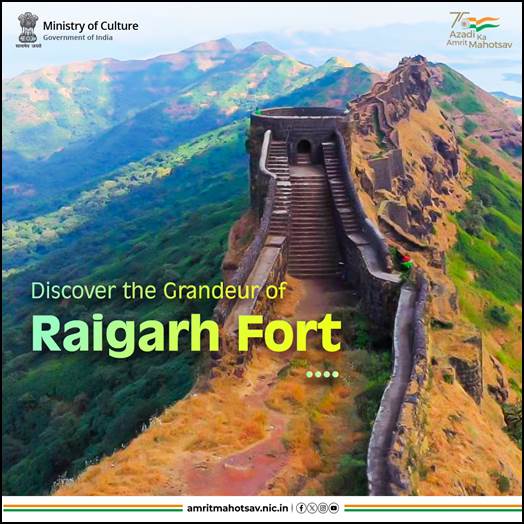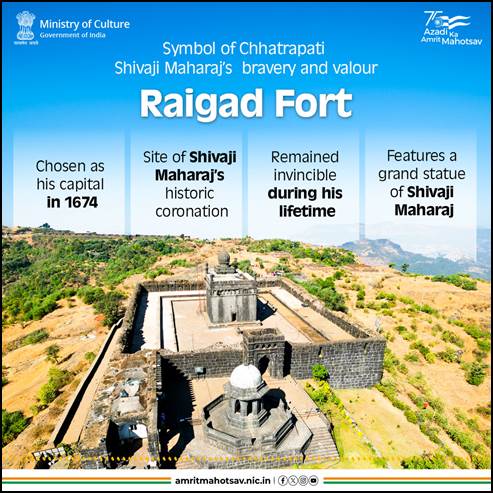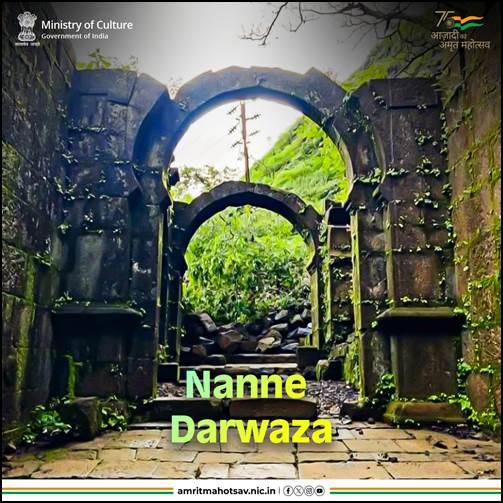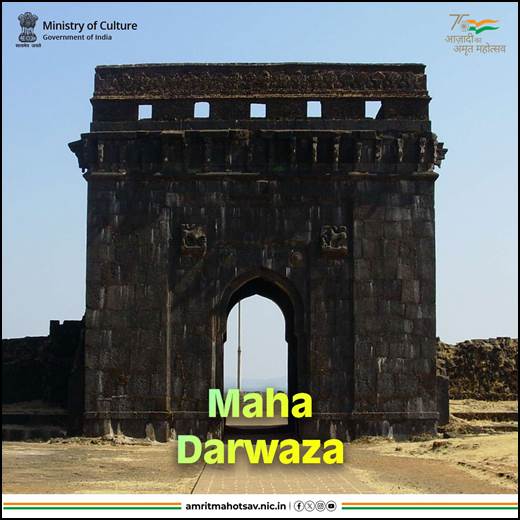Ministry of Culture
Raigad Fort: Capital of most illustrious Maratha sovereign, nurtured by Chhatrapati Shivaji Maharaj
प्रविष्टि तिथि:
28 OCT 2024 1:45PM by PIB Delhi
दख्खन की यह पावन मिट्टी।
छत्रपति के चरण धूल की।।
सर झुकता है रायगड पर।
राजधानी यह स्वराज्य की।।
The fort of Raigad is part of the 12 forts nominated for UNESCO World Heritage under the title “Maratha Military Landscapes of India”
Among the 12 nominated forts, Raigad is the classic example of Maratha architecture and best representation of the capital fort on a hill
Theme of the backdrop of this year’s Rashtriya Ekta Divas celebrations at Kevadiya, Gujarat is the Raigad Fort
A replica of Raigad Fort has been made as backdrop at the venue of Rashtriya Ekta Diwas parade in Kevadiya to showcase the stories of incredible valour, heroic deeds and innovative warfare techniques of Chhatrapati Shivaji Maharaj
Grant Duff, a British historian drawn parallels between Raigad and the Rock of Gibraltar, labeled Raigad as the Gibraltar of the east
DURGRAJ RAIGAD
Towering above the valleys of Maharashtra, Raigad Fort carries the echoes of Chhatrapati Shivaji Maharaj’s reign. Once the capital of his flourishing Maratha Empire, this hilltop stronghold carries with it the stories of bravery, innovation, and heroism. Each stone of Raigad echoes the remarkable courage and visionary tactics of Shivaji Maharaj, whose leadership transformed this fort into a symbol of strength. Today, it continues to inspire, reminding generations of the extraordinary deeds that shaped the history of an empire.

The “Sabhasad Bakhar” (Ancient letter) reflects how Chhatrapati Shivaji Maharaj selected the Raigad fort as the capital of the Maratha Empire. It mentions, “Chhatrapati Shivaji Maharaj observed the potential of the hill or Rairi, which has steep escarpment and is the tallest of all mountains and hills in the region. The seamless and unbroken nature of the rock was a great potential. The fort of Daulatabad is also a good fort, however, it is not as good as Raigad, as this is taller and better, hence will be most suitable as a capital and a throne for the king.”

Raigad, surrounded by valleys shaped by the Kal and Gandhari rivers, stands as an isolated massif without connections to neighbouring hills. Its impregnable nature, attributed to physiographic features like steep cliffs and 1500-foot escarpments, is underscored by innovative military defence tactics.
Grant Duff, a British historian of the Maratha period has drawn parallels between Raigad and the Rock of Gibraltar. He has gone to the extent of labelling Raigad as the Gibraltar of the east.
The fort of Raigad is part of the 12 forts nominated for UNESCO World Heritage under the title “Maratha Military Landscapes of India”. Among the 12 nominated forts, Raigad is the classic example of Maratha architecture and best representation of the capital fort on a hill, well integrated with the physiography of the hill with the most developed typologies of structures within the fort.

The theme of the backdrop of this year’s Rashtriya Ekta Divas celebrations at Kevadiya, Gujarat is the Raigad Fort. A replica of Raigad Fort has been made as backdrop at the venue of Rashtriya Ekta Diwas parade in Kevadiya to showcase the stories of incredible valour, heroic deeds and innovative warfare techniques of Chhatrapati Shivaji Maharaj.
History of Raigad Fort
In 1653 CE, Raigad (then known as Rairi) was captured by the Maratha forces from the Mores'. In order to make the fort worthy of being a capital, Shivaji Maharaj assigned the work of reconstruction of the fort to Hiroji Indulkar. Subsquently, on 6th June, 1674 CE a grand coronation ceremony of Shivaji Maharaj was held on Raigad post, during which he attained the title of “Chhatrapati”. The fort served as the second capital of Chhatrapati Shivaji Maharaj and played an important role in the administration and expansion of the Maratha Kingdom.
The Raigad Fort stands as a silent reminder of Maharashtra's glorious past and it is identified as Durgaraj (king of forts). Various landmarks have lent it the credo of 'Shiva teerth'. The fort has attained the status of a holy shrine for the Shivbhakts as thousands of people throng the fort not only for its heritage character and it being a specimen of perfect defence architecture but also for being the seat of their role model, Chhatrapati Shivaji Maharaj, who is well known for valour, courage, administrative acumen, benevolence and patriotism. Anniversary of Shivrajyabhishek on the basis of Christian and Hindu calendars is celebrated with great enthusiasm which attract huge crowd from different parts of Maharashtra. Similarly, the death anniversary (punyatithi) of Shivaji Maharaj is also observed with great reverence.
It was here that Shivaji Maharaj had established his capital in the seventeenth century (1674 CE). Shivaji Maharaj had wrested the Fort from Chandrarao More in 1656 CE. It was considered most suitable for the capital of Hindvi Swaraj after due diligence and considering its strategic location and inaccessibility. The hilltop may only be accessed from one side of the hill. Shivaji Maharaj had ruled Hindvi Swaraj from Raigad Fort for six years till his death in 1680 CE. There is a Samadhi of Chhatrapati Shivaji Maharaj at Raigad Fort.
Raigad Fort is remarkable for magnificently designed gates, fortification walls and imposing monuments. It is quite unfortunate that except Shivaji Maharaj's Samadhi, Naqqar Khana, Sirkai Devi Temple, Jagadishwar Temple – a shrine dedicated to Lord Siva - most of the structures located within the fort, including the Hall of Public Audience (Rajsadar), Royal Complex, Queens' palace (Ranivasa), Bazarpeth, Manore (pleasure pavilions), Wadeshwar Temple, Khublada Burj, Massid Morcha, Nanne Darwaza are in a bad state of preservation.

The royal complex: The Royal Complex which includes Ranivasa, Rajsadar, Naqqarkhana, Mena Darwaza, and Palkhi Darwaja, is well-fortified and accessible only through three entrances: Naqqarkhana, Mena Darwaja, and Palkhi Darwaja. This fortified complex is commonly known as Balle Qilla (citadel). Adjacent to Balle Qilla are three elegant towers. One is located to the north, while the other two are situated to the east of the fortification wall. The three-storied towers (Manore) are highly ornate in design and appear to have originally served as pleasure pavilions. A toilet connected with proper drainage is noteworthy. An underground cellar (Khalbat Khana) is situated on the east, which was possibly used for secret meetings, personal worship, and also as a treasury.

Rajsadar (Hall of Public Audience): This is where Shivaji Maharaj used to hold his court (darbar) to dispense justice on routine matters and to receive dignitaries and envoys. It is a rectangular structure facing east. It can be approached from the east through a magnificent gateway commonly known as Naqqarkhana. The gateway is a lofty three-storeyed structure facing the royal throne. While the topmost storey is built of bricks, the lower ones are constructed of stone blocks. It is believed that a royal band used to play at Naqqarkhana. It is an excellent example of architecture with astounding acoustic properties. The distance between Naqqarkhana and the royal throne is about 65 meters, yet even the slightest whisper can be heard clearly from both ends. Rajsadar is a mute witness to the joys, sorrows, anger, victories, administrative acumen, and overwhelming generosity of Shivaji Maharaj.
The main platform accommodates an octagonal meghdambari (ornate canopy) with a seated image of Chhatrapati Shivaji Maharaj raised over the original site of the throne. It has been recorded that the royal throne, studded with diamonds and gold, rested on eight columns of gold weighing almost 1000 kg. It also bore the royal emblem of Shivaji Maharaj. The umbrella over the throne was adorned with strings of precious stones and pearls.

Holicha Mal: It is located outside Naqqarkhana. It is a wide-open ground that was most likely used for the annual Holi festival. On the western periphery of Holicha Mal, there is a small temple dedicated to Shirkai Bhavani, the presiding deity of the fort. It is believed that the presiding deity was originally housed on a high stone plinth located in the southwest of Holicha Mal, which was later shifted to its current location. To the north of Holicha Mal, there is a spacious and well-laid-out parallel row of structural units, commonly known as Bazar Peth. Each unit in this complex features a veranda in front and two back-to-back rooms in the rear. The plinth and walls are constructed from semi-dressed basalt stone blocks and random rubble stones, with lime invariably used as mortar.
Jagadishwar Mandir: The temple, facing east, is rectangular on plan with a mandapa in front and sanctum sanctorum on the rear. The temple could be entered through a low-height entrance. The sanctum sanctorum has a Siva linga which is under worship even now. The interior walls of the temple are without any carvings. However, the projected superstructure is supported by elegantly carved brackets.
Samadhi of Chhatrapati Shivaji Maharaj: Adjacent to the Temple, the Samadhi of Chhatrapati Shivaji Maharaj is located almost opposite to the eastern entrance of Jagadishwar Mandir. Originally, the Samadhi had a low height octagonal platform only. But, sometimes in the beginning of the twentieth century not only the height of the platform was raised but a canopy too had been constructed at the same site.
At the foothills, near the Raigadwadi village, is located Chitta Darwaza. It is also known locally as Jit Darwaja. After trekking by foot for about 70-80 m, there exists Khoob Lada Burj. It is a strategically located tower from where anyone coming close to the fort could easily be spotted by the security personnel.
*****
Santosh Kumar
(रिलीज़ आईडी: 2068819)
आगंतुक पटल : 7139